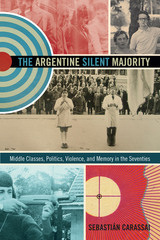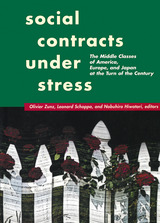3 books about Middle Classes

The Argentine Silent Majority
Middle Classes, Politics, Violence, and Memory in the Seventies
Sebastián Carassai
Duke University Press, 2014
In The Argentine Silent Majority, Sebastián Carassai focuses on middle-class culture and politics in Argentina from the end of the 1960s. By considering the memories and ideologies of middle-class Argentines who did not get involved in political struggles, he expands thinking about the era to the larger society that activists and direct victims of state terror were part of and claimed to represent. Carassai conducted interviews with 200 people, mostly middle-class non-activists, but also journalists, politicians, scholars, and artists who were politically active during the 1970s. To account for local differences, he interviewed people from three sites: Buenos Aires; Tucumán, a provincial capital rocked by political turbulence; and Correa, a small town which did not experience great upheaval. He showed the middle-class non-activists a documentary featuring images and audio of popular culture and events from the 1970s. In the end Carassai concludes that, during the years of la violencia, members of the middle-class silent majority at times found themselves in agreement with radical sectors as they too opposed military authoritarianism but they never embraced a revolutionary program such as that put forward by the guerrilla groups or the most militant sectors of the labor movement.
[more]

Makers of Democracy
A Transnational History of the Middle Classes in Colombia
A. Ricardo López-Pedreros
Duke University Press, 2019
In Makers of Democracy A. Ricardo López-Pedreros traces the ways in which a thriving middle class was understood to be a foundational marker of democracy in Colombia during the second half of the twentieth century. Drawing on a wide array of sources ranging from training manuals and oral histories to school and business archives, López-Pedreros shows how the Colombian middle class created a model of democracy based on free-market ideologies, private property rights, material inequality, and an emphasis on a masculine work culture. This model, which naturalized class and gender hierarchies, provided the groundwork for Colombia's later adoption of neoliberalism and inspired the emergence of alternate models of democracy and social hierarchies in the 1960s and 1970s that helped foment political radicalization. By highlighting the contested relationships between class, gender, economics, and politics, López-Pedreros theorizes democracy as a historically unstable practice that exacerbated multiple forms of domination, thereby prompting a rethinking of the formation of democracies throughout the Americas.
[more]

Social Contracts Under Stress
The Middle Classes of America, Europe, and Japan at the Turn of the Century
Olivier Zunz
Russell Sage Foundation, 2002
The years following World War II saw a huge expansion of the middle classes in the world's industrialized nations, with a significant part of the working class becoming absorbed into the middle class. Although never explicitly formalized, it was as though a new social contract called for government, business, and labor to work together to ensure greater political freedom and more broadly shared economic prosperity. For the most part, they succeeded. In Social Contracts Under Stress, eighteen experts from seven countries examine this historic transformation and look ahead to assess how the middle class might fare in the face of slowing economic growth and increasing globalization. The first section of the book focuses on the differing experiences of Germany, Britain, France, the United States, and Japan as they became middle-class societies. The British working classes, for example, were slowest to consider themselves middle class, while in Japan by the 1960s, most workers had abandoned working-class identity. The French remain more fragmented among various middle classes and resist one homogenous entity. Part II presents compelling evidence that the rise of a huge middle class was far from inclusive or free of social friction. Some contributors discuss how the social contract reinforced long-standing prejudices toward minorities and women. In the United States, Ira Katznelson writes, Southern politicians used measures that should have promoted equality, such as the GI bill, to exclude blacks from full access to opportunity. In her review of gender and family models, Chiara Saraceno finds that Mediterranean countries have mobilized the power of the state to maintain a division of labor between men and women. The final section examines what effect globalization might have on the middle class. Leonard Schoppa's careful analysis of the relevant data shows how globalization has pushed "less skilled workers down and more skilled workers up out of a middle class that had for a few decades been home to both." Although Europe has resisted the rise of inequality more effectively than the United States or Japan, several contributors wonder how long that resistance can last. Social Contracts Under Stress argues convincingly that keeping the middle class open and inclusive in the face of current economic pressures will require a collective will extending across countries. This book provides an invaluable guide for assessing the issues that must be considered in such an effort.
[more]
READERS
Browse our collection.
PUBLISHERS
See BiblioVault's publisher services.
STUDENT SERVICES
Files for college accessibility offices.
UChicago Accessibility Resources
home | accessibility | search | about | contact us
BiblioVault ® 2001 - 2024
The University of Chicago Press









